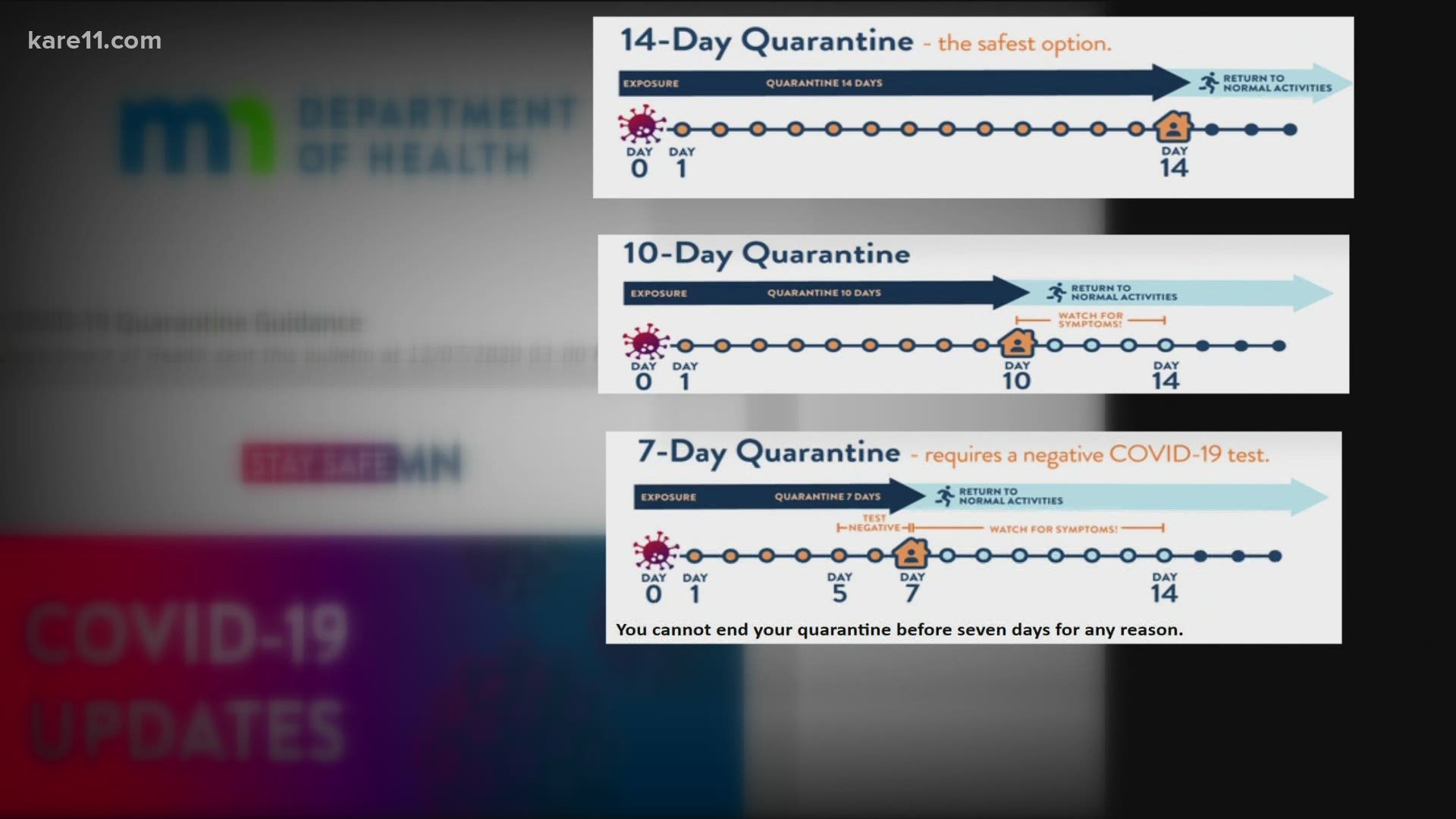ST PAUL, Minn — Minnesota is shortening its COVID-19 quarantine length to align with the recent shift by the Centers for Disease Control and Prevention (CDC).
Last week, the CDC loosened its quarantine guidelines for people who have had close contact with a COVID-19 case. The new guidance allows people to stop quarantine after 10 days, or seven days with a negative test on day five or later.
The CDC still endorses a 14-day quarantine, according to its website, but is attempting to balance the "reduced burden against a small possibility of spreading the virus."
Walz and the Minnesota Department of Health (MDH) had yet to adjust Minnesota's guidance in light of the change until Walz announced Monday that the state will align with the CDC.
The governor pointed out that the science has continued to evolve since the COVID-19 pandemic first hit. He reiterated that 14 days is still the general timeframe where someone who's been exposed to COVID-19 has been observed to pass it on.
"Obviously, the longer you would quarantine, the lower chance of you spreading it to someone," Walz said. "But what we’ve found is the chance of you spreading it to others after 10 days is even less."
Walz said that the shortened quarantine period is solely a calculated move to allow more people to abide by the guidance.
"The science has not changed, it's just a refinement to make sure that we can get higher compliance," Walz said. "If we could get more people to quarantine for 10 days even, that would have an impact on the spread of the virus. And the belief here is that intersection of the science and the ability of people to comply with it to stop the spread of the virus."
Walz said that Minnesota still recommends that "if you are capable" you should quarantine for the full 14 days after close contact. But he acknowledged that not everyone can do this easily.
"Being able to quarantine for 14 days, that sometimes comes with a little bit of privilege or luxury that you’re able to do it," Walz said.
The CDC says it loosened the quarantine requirement because it "may make it easier for people to quarantine by reducing the time they cannot work."
MDH Commissioner Jan Malcolm said Monday that the CDC's change gave states the "option" to shorten their quarantine guidance. Malcolm said that health officials believe there is a "net gain" to be made by shifting to the shorter quarantine and getting more people to comply, by trimming off the lower-risk days at the end.
"Their risk of being infectious tends to wane as that 14 days goes by," Malcolm said. "But it doesn't come risk-free. ... There is still a small risk."
Therefore, continuing to monitor symptoms through the full 14 days is important, Malcolm said.
"Any symptom means you should go back," MDH Infectious Disease Director Kris Ehresmann said.
Malcolm emphasized that "quarantine" is different from "isolation." Quarantine is the period that a person should stay home after having close contact with a COVID-19 case. This is different from the isolation a person should go into once they themselves have tested positive. Guidelines for isolating when you are sick are available on the MDH website, and those have not changed.
Ehresmann said there are some circumstances where MDH does not recommend shortening the quarantine period:
- Household exposure
- Congregate living exposure
- If you are a worker in congregate care
- If you are a health care worker
Ehresmann clarified that if one household member has contact with a COVID-19 case, the rest of the family does not have to quarantine. However, if that household member then contracts COVID-19, their family should then quarantine for the full 14 days. She also said that MDH is "in dialogue" with health care facilities, because the 14-day quarantine is making staffing so difficult.
Walz again told Minnesotans that wearing masks is one of the most important things they can do to stop the spread of COVID. He said 72% of Minnesotans report that they are wearing masks when they go out. Malcolm said survey data from late September and October shows that Minnesotans are doing a better job wearing masks in public, running errands for instance, but self-report that they are less vigilant when they are in social gatherings with friends and family.
Walz said that on Tuesday, he will hold a news conference to give more details on Minnesota's vaccine rollout plans.
Also happening Tuesday, a group of Minnesota Republicans will unveil their proposal to include teachers at the front of the line for the COVID-19 vaccine.
The announcement, hosted by Rep. Peggy Scott and Sen. Michelle Benson, will happen at 9:30 a.m.

